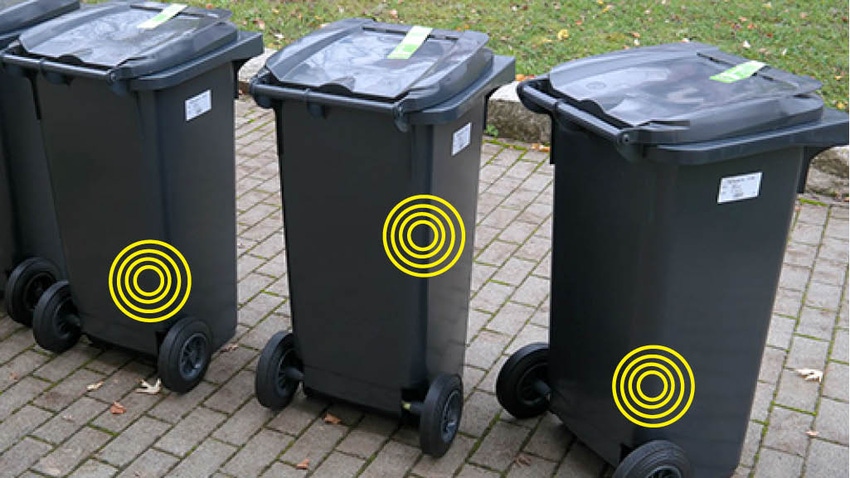Canadian Start-Up Launches Pilot Tracking Fill-Levels of Campus Bins
The pilot is aimed at improving waste collection efficiencies by providing optimized route planning and pick-up while reducing costs.

A Waterloo, Ontario, Canada-based technology company is looking to make one Canadian university a bit smarter through real-time tracking of fill-levels of on-campus outdoor waste disposal and recycling bins specifically associated with the campus parking facilities.
The firm, eleven-X Inc., is a member of the LoRa Alliance, the global association of companies backing the LoRaWAN standard for low-power wide-area IoT (Internet of Things) networks (LPWANs). It has launched its second “smart campus” pilot program with the University of British Columbia (UBC).
The company is the latest entrant in the field of competitors that measure container fill levels. Finnish company Enevo has developed a wireless sensor that can be affixed to a full range of refuse containers carrying all types of garbage. San Francisco-based Compology has developed rugged sensors for the insides of roll-off and front-load containers to track fullness, GPS location and motion information. OnePlus Systems produces OnePlus Compactor Fullness Monitors as well as the OnePlus Metro Series for smaller containers. In June 2016, it also acquired Dublin, Ireland-based SmartBin, which extended its capabilities to smaller waste receptacles like bins, dumpsters and liquid containers.
For eleven-X, the UBC pilot is aimed at improving waste collection efficiencies by providing optimized route planning and pick-up while reducing costs by optimizing schedules and eliminating the need for emergency call-outs.
“It’s really more of a collaborative effort. We have a number of certified partners that provide devices for applications for our customers,” says eleven-X President and CEO Dan Mathers. “In this particular case, we utilized one of our device partners who provided the fill-level sensors that will be installed in a sampling of the university’s waste and recycle bins across the campus parking lots.”
The sensors will be connected to the eleven-X public LoRaWAN and communicate real-time the fill-levels of each of the bins. The maintenance staff of UBC will be able to track levels through a dashboard and determine optimized routes and pick-ups. In addition, if a bin starts to reach a pre-configured level, an alert is sent to the maintenance team letting them know a pick-up is needed.
“I came across LoRa networking and some of the solutions (in this case waste management) at Smart City Expo in Barcelona last year,” says Brian Jones, director of parking and access services for The University of British Columbia in Vancouver, BC, Canada. “When we started to look at possible pilots using LoRa technology, we came across eleven-X, who I believe are one, if not the only, commercial suppliers of this technology in Canada. And that’s how we got connected.”
UBC and eleven-X first collaborated on an accessible smart parking pilot, currently underway, which will be completed in spring 2018.
“UBC has assessed several IoT technologies as part of their process and we are very pleased they selected eleven-X to collaborate on what is now our second initiative,” says Mathers.
The data collected in the smart parking initiative will help officials build out parking profiles that can be analyzed and evaluated to ensure effective use of the stalls. The goal is to improve the parking experience for students, staff and visitors requiring accessible parking.
The latest project is expected to last approximately three months, enabling sufficient data capture across specific target areas of UBC parking’s waste collection process. This data will be used to evaluate possible future deployments across other areas of the UBC parking’s portfolio.
“We’ll get lots of data to know with accuracy what’s happening with those garbage and recycling containers,” says Jones. “That means we know when they’re full so we don’t waste time going to check on containers that are not full. There is a productivity benefit here.”
The UBC parking department also will be notified when bins need emptying to avoid overfilling and spillage of waste onto the ground. “Parking is often the first and last impression people have on arrival and departure so simple things like overflowing bins with litter everywhere doesn’t look good. So there’s obvious environmental and rotational benefits here,” says Jones.
Mathers says that with any IoT project, the key areas where the value is recognized is with improved efficiencies and productivity, reduced costs and the benefits to the environment.
“What this solution really does is take the guesswork out of managing and maintaining waste and recycle containers of any size. Pick-ups can be timed based on actual data—real-time, historical and filling trends—and allows organizations to optimize pick-up routes,” he says. “There are real costs associated with this—time, materials and man-hours—as well aesthetic costs. No one wants to see or be exposed to someone else’s garbage so, in addition to cost savings, there is a risk management component as well.”
According to Jones, UBC parking is working closely with UBC researchers from engineering on the technical use and application of LoRa mesh networking—principally as a precursor to better understanding “smart city” application.
“In a nutshell, I’m looking to establish ‘smart parking’ and then potentially scale that up in conjunction with other UBC partners,” he says.
Adoption of this technology is wide ranging—from school campuses like UBC to a number of global and Fortune 500 companies, as well as cities and municipalities, says Mathers.
“The future is wide open … the idea of fill-level tracking isn’t necessarily new, but the fact that it can now be tracked, and data collected and analyzed to improve the service while reducing costs is what is exciting,” he says. “Moving forward it can be about what other data can be collected from the bins—perhaps we can learn to understand the impact on different types of recycling or waste and possible effects it may have on the direct environment as it breaks down in the container. Lots of possibilities exist.”
About the Author(s)
You May Also Like


